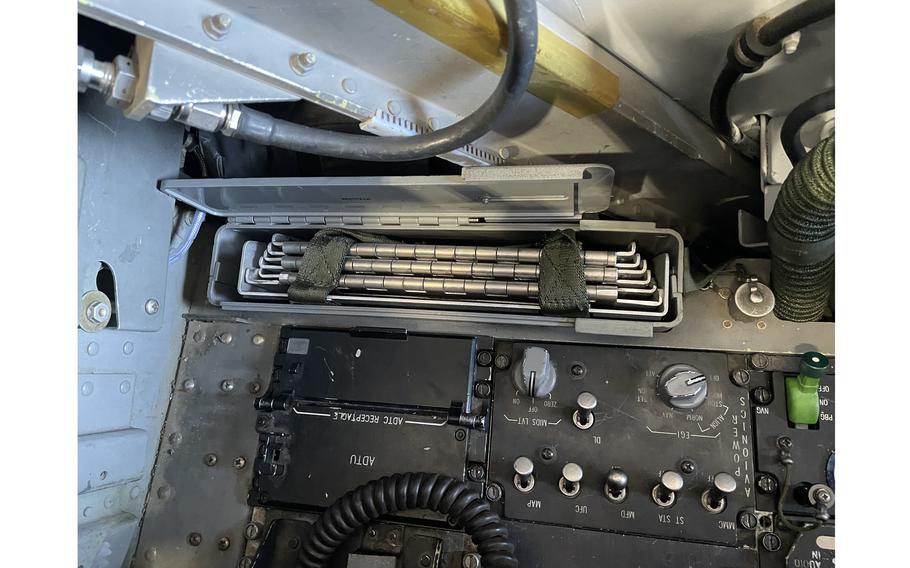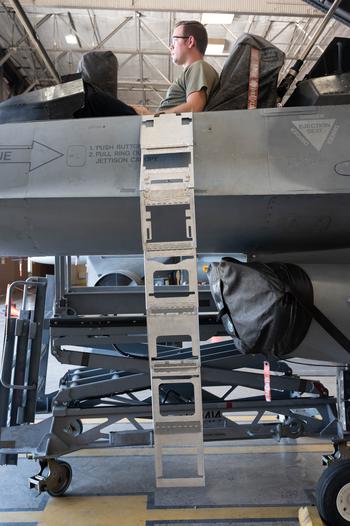
A prototype collapsible ladder for the F-16 Viper is stored in the cockpit map case. The idea for the ladder came from Maj. Nicholas Atkins, an F-16 pilot at Aviano Air Base in Italy. (Nicholas “Trapper” Atkins/U.S. Air Force)
AVIANO, Italy — An airman from the 31st Fighter Wing at Aviano Air Base thinks he has devised a top-rung method of cockpit ingress and egress for F-16 Viper pilots.
Maj. Nicholas Atkins conceptualized a collapsible ladder that fits in the jet’s map case, and then he turned to the 9th Training Support Squadron at Luke Air Force Base in Arizona to design it.
A prototype, which was redesigned several times before taking its current form, is being tested now at the installation in Italy.
“Our next step is to work toward approval and certification of the ladder on the aircraft here at Aviano,” said Atkins, who is an F-16 pilot and the wing’s deputy chief of plans and programs.
Atkins also entered the apparatus for consideration in the annual Air Force innovation competition Spark Tank.
The idea behind the Spark Tank pitch is to seek “Air Force-level support to help expedite that approval process and work to get these ladders out” to airmen throughout the service, Atkins said.
In contrast with pilots of many other aircraft, those who fly the F-16 rely on a ladder that is prepositioned ahead of time to get into and out of the cockpit safely.

A prototype ladder for the F-16 Viper is draped over the side of the aircraft. The collapsible ladder is being tested at Aviano Air Base in Italy. (Nicholas “Trapper” Atkins/U.S. Air Force)
But those ladders are bulky and limited in number, so it isn’t feasible to put them everywhere ahead of time, Atkins said.
In the Spark Tank submission, Atkins listed two things needed from the Air Force for this project. The first is subject matter experts in agile combat employment.
That’s because they are the ones who can certify anything that touched the aircraft, he said.
ACE is a set of concepts that involves rapid deployment of aircraft from larger overseas installations to groups of smaller, often remote locations with minimal infrastructure support.
The concept is designed to make it more difficult for adversaries to predict aircraft movements and target those bases in war. The Air Force has been developing and refining ACE training for the past several years.
“Besides all the ACE advantages this ladder helps enable, it would also be an excellent alternative to the current legacy ladder for contingency-type operations,” Atkins said.
For example, the hip-pocket ladder offers lots of flexibility in various situations and lets both pilots and crew chiefs avoid the risks of having to climb down the side of the aircraft, according to Atkins.
The other requirement laid out by Atkins is financing. Each ladder costs $300 for parts and $1,500 for labor.
The 9th Training Support Squadron is providing the labor for free, but it still costs about $43,000 for 144 ladders, which is the number Atkins said is needed to outfit the eight overseas F-16 squadrons. If labor costs were included, the total would be $259,000, according to Atkins.
The legacy ladders used now on F-16s cost $5,200 apiece, Atkins said in the Spark Tank submission.
The plan envisions a rollout starting with 36 ladders for the F-16s at Aviano and then expanding to the rest of the European and Pacific theaters.
That plan would supply the ladders to those “closest to the fight and most likely to immediately ACE,” Atkins said in the submission.
Assuming the ladder works as intended and achieves certification, the goal is to make them available for all 936 of the Air Force’s F-16s.
The idea for Aviano prototype came about when Atkins saw Lt. Col. Lawrence Dietrich’s design of a collapsible ACE ladder for the F-22.
It was born out of the frustration Atkins said he felt during the “numerous times” in his Air Force career he had found himself without a ladder.